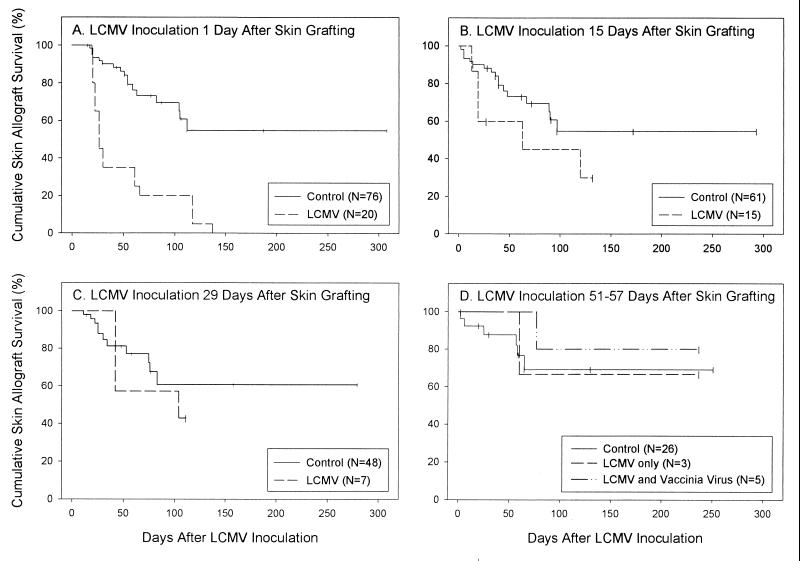FIG. 1.
Skin allograft survival in uninfected and LCMV-infected mice. C57BL/6 mice were treated with a single donor-specific BALB/c spleen cell transfusion and a brief course of anti-CD154 MAb and given a BALB/c skin graft as described in Materials and Methods. Transplantation was performed on small groups of animals over the course of several weeks, as animals became available. A cumulative total of 96 tolerized, transplanted animals was used in this experiment. (A) On the day after transplantation, a cohort of 20 mice was injected with LCMV; the remaining animals were untreated. Skin allograft survival in this group was statistically significantly shorter than that in the pool of all other uninfected transplanted mice (P < 0.001). (B) On day 15 after transplantation, 15 recipients from among the uninfected controls with successful grafts (A) were injected with LCMV. There was no statistically significant difference in overall graft survival between this group and the pool of all remaining uninfected animals (P = 0.06). (C) On day 29 after transplantation, seven of the recipients from among the uninfected controls that had not spontaneously rejected their grafts (B) were selected and injected with LCMV. Graft survival in this group was statistically similar to that observed in the pool of all remaining uninfected control animals (P = 0.54). (D) On days 51 to 57 after transplantation, eight recipients from among the uninfected controls that had not spontaneously rejected their grafts (C) were selected and injected with LCMV. Three of the tolerized recipients infected with LCMV received no other intervention; one recipient rejected its graft 60 days after LCMV infection. Five of the tolerized recipients infected with LCMV, whose grafts then survived 47 days after infection, were further challenged with 106 PFU of VV strain WR injected directly into their grafts. One of these animals rejected its graft 30 days later; the remaining grafts survived through the end of the experiment. Graft survival in the two virus-treated groups was statistically similar to that in the pool of all remaining uninfected controls. Each panel shows graft survival relative to the day of LCMV injection. Cumulative graft survival was calculated by the method of Kaplan and Meier, which takes into account the successive removal of mice from the pool of control animals. Vertical bars indicate censored data (i.e., animals with intact grafts at the conclusion of the study and animals removed at successive intervals for use in the timed infection experiments shown in panels B and C).

